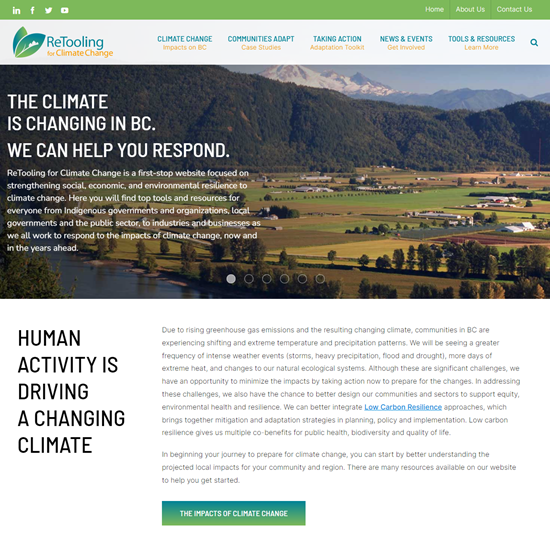Adaptation
The challenge of a changing climate
BC’s climate is changing and climate scientists are projecting further changes over the coming decades. Climatic change and its impacts will vary from place to place and region to region. Anticipated climate trends include:
- Hotter drier summers
- Warmer winters with increased precipitation
- Increasing frequency and intensity of storms
- Increasing intensity of extreme winds
- Sea level rise
The result of these trends is that BC may experience increased severity and frequency of climate change-induced events. These include:
- Wildfires
- Flooding
- Coastal erosion
- Soil erosion and landslides
- High temperatures and drought
Learn more about potential climate change impacts in BC.
Adaptation involves reducing risk and vulnerability by preparing for these changes and the impacts they will have on communities and natural systems. Managing these risks now is essential to protect our physical, social and mental well-being, our environment and biodiversity, and our economy for generations to come. A community that is resilient can bounce back faster, stay healthier, perform better economically, and enhance livability for future generations
Retooling for Climate Change
A comprehensive adaptation resource
The Retooling for Climate Change website includes news, best practice stories, discussion of how communities can take action across 12 topic areas, and links to data and resources. It is funded through the BC Regional Adaptation Collaborative (BC RAC), a partnership program of the Fraser Basin Council and the BC Ministry of Environment – Climate Action Secretariat, with funding from Natural Resources Canada.
BC communities are already experiencing the impacts of climate change, including extreme weather, floods, wildfires and drought, some with several events in the same year. Impacts depend on variables such as geography, topography and local climate conditions and are therefore specific to each community.
Local governments are using adaptation tools and frameworks to assess risk and vulnerability unique to their local conditions. Addressing adaptation is a shared responsibility among federal and provincial governments, local governments, Indigenous Peoples, the private sector, non-government organizations, industry and homeowners. We all need to work together.
Planning and taking action
According to the Federation of Canadian Municipalities (FCM), municipalities own and operate 60% of public infrastructure in Canada. This infrastructure is vulnerable to the climate change impacts noted above. Infrastructure may be lost or damaged and require replacement or repair. Research has shown that the cost of identifying vulnerabilities and undertaking adaptation actions is cheaper than the cost of restoring infrastructure after it has been damaged.[1]
Past development decisions have resulted in established land use patterns that are not supportive of community sustainability and resilience in a future of increased climate change-induced risk and vulnerability. While this introduces some uncertainty into planning for the future, it is important to take adaptation and emission mitigation actions now and to keep them as responsive as possible.
Local governments are increasingly focused on adapting to climate change impacts by addressing economic, social, cultural and environmental issues while also planning sustainable resilient communities that are compact, complete, and connected. The goal of planning for adaptation is that these communities are better prepared for challenges and can bounce back faster if impacted by a climate change event.
If your community is starting to address adaptation, there are several guidance resources available to develop terms and reference and identify project requirements.
- Retooling for Climate Change (BC Regional Adaptation Collaborative)
- Plan2Adapt, published by the Pacific Climate Impacts Consortium, generates maps, plots, and data describing projected future climate conditions for regions throughout British Columbia and is designed to help assess climate change impacts.
- Preparing for Climate Change: An Implementation Guide for Local Governments in BC, developed by the West Coast Environmental Law Centre, reviews tools and highlights experiences and good practices from BC and elsewhere in Canada.
- Building Adaptive & Resilient Communities, developed by ICLEI – Local Governments for Sustainability, provides a comprehensive framework to respond to the impacts of climate change, develop and implement an adaptation plan, and protect the people, property, and prosperity
- Canadian Institute of Planners Climate Change Policy defines climate planning policy directions for the built environment, natural environment, and social environment. It also outlines the role of planners in facilitating dialogue and collaboration.
If your local government has had experience with adaptation projects or approaches, please share your results and learnings with the Toolkit.
